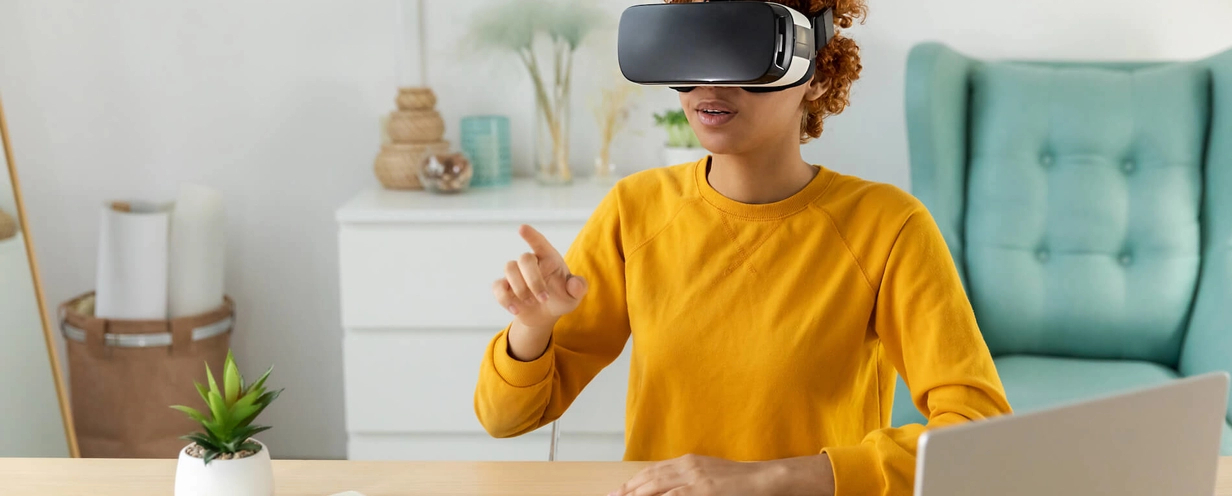
Reality bytes: How UX research can take advantage of VR

Every sci-fi film for decades has shown virtual reality as the basis of everyday life in the future, and now the technology is a reality in many homes.
However, VR still isn’t used for much more than gaming. This begs the question: are we using virtual reality to its full potential? Let’s discover how UX teams can use VR technology to build better experiences long before they become reality.
Virtual reality check
VR is now a viable product for home use. Google created a way of turning your phone into a low-end VR headset with a folded piece of cardboard.
These products allow you to play VR games, from haunted-house experiences to first-person shooters in a 360-degree environment. And for non-gamers, certain apps will let you experience landscapes or watch 360 videos of real rollercoaster rides in VR.
Still, the experiences are rooted very much in leisure.
Perhaps the only option for anything more practical is the VRChat system, which allows you to meet, chat and explore a virtual world with random people from the internet, to whom you appear as Kermit from the Muppets or an anime character wielding twin pistols.
This is about as close as we can get to the Matrix-like vision of the future, but is it more useful for anything other than a good time?
Virtual analogy
Novels like Neal Stephenson’s Snow Crash, films like Virtuosity and The Cell, and anime like Ghost In The Shell predicted VR being used for more practical purposes. Sci-fi had us believing that VR would be used for virtual conference calls or treating psychological disorders.
The Marvel superhero movies, for instance, had Iron Man’s alter ego, Tony Stark, working out some mental health issues regarding his father’s death in a virtual recreation of their last conversation.
What we have that these superheroes don’t is the need to strap on a big, clunky headset before you can take advantage of the VR world. We’re still waiting on smaller, more-comfortable VR headsets or, as Star Trek predicted, a holographic environment that doesn’t require a headset at all, but these options are a long way off.
The closest we’ve come is augmented reality (AR), an attempt to offer a VR experience through a screen. Rather than using a hugely complicated piece of tech that you need to attach to your head, AR superimposes computer-generated items onto your phone camera screen.
The most practical use of this was probably Google’s Lens glasses, which could display Google Maps information in front of your eyes as you looked around for directions. Sounds handy, and Google Lens was certainly a lot more practical than a full VR rig, but the item was withdrawn due to a lack of demand.
Virtual realness
A quick Google of the terms ‘VR’ and ‘user experience’ together will bring up a wide selection of articles saying how important VR will be for the future of UX, but they’re less clear on what it will be used for.
Will we ever put on a headset and wander down the aisles of a VR supermarket to pick out items that will later be delivered to our door? Probably not, as I don’t particularly see how holding a virtual loaf of bread will improve the online shopping experience.
Much of what we do on a computer is shorthand for what we do in real life—online shopping, social media, etc. Putting on a VR rig and navigating your way through a 3D simulation of a library is just so much more effort than looking something up on Wikipedia.
Virtual actuality
However, one area in which we’re already seeing VR being utilized beyond gaming is virtual experiences.
Getting to a car showroom is not always the easiest journey, particularly under the current circumstances. You could, however, allow your customers to strap on their home VR headset and take a walk around your new-model car, maybe even climb inside and get an idea of the size and layout. They could even potentially take a VR test drive.
Likewise, it’s relatively easy to turn your advert concept into a short VR game with interactive elements. Rather than something on the other side of a screen, you can turn your advert into a truly involving, emotive experience that your customer won’t forget for some time.
It may seem hard to believe that virtual reality could be much more real than watching TV, but clinical research backs it up. Indeed, virtual reality is touted as effective in 90% of cases when used as an aid to cognitive behavioral therapy.
There’s even talk about the possible use of VR to train amputees to use prosthetic limbs and overcome issues with phantom limb syndrome.
What about UX, specifically? Can VR experiences help us with UX prototyping? Absolutely.
Virtual audacity
While VR isn’t yet useful for shorthand experiences, like online shopping, what about user research for physical items and areas? What if you wanted to test out the layout of a new supermarket?
Build a virtual version of your store, add a bunch of customers, and see how they move around your shop. Is there enough room for the trolleys to get past? Will they go to the right areas? Can they find the tills, the toilets, and the exit?
VR can answer these questions without building your layout in the real world.
That principle can also apply to any physical product. Want to see how easy it is to reach the gear stick on your new car dashboard? Can you switch on your prototype kettle without knocking it over? Is your new heavy machinery likely to cause injury? Try it out in VR.
Virtual potentiality
The real potential of VR is in taking your concept and transporting your customers directly into your imagination to conduct user research before you’ve even built a prototype.
Even the best VR rigs will be cheaper than a full manufacturing process, which could lead to nothing if testing goes poorly.
What’s VR good for? Maybe not everything we hope for just yet, but we can already take advantage of what VR can do for us right now, and it’s very promising.
In this Article

The UX research methodology guidebook
The UX research methodology guidebook


